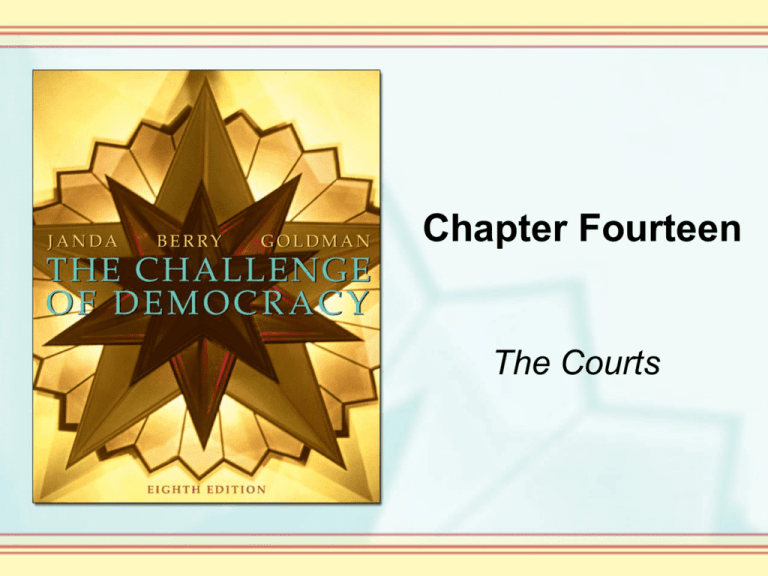
Chapter Fourteen
The Courts
National Judicial Supremacy: The Role of
the Courts in American Government
• American courts shape policies that form
the heart of American democracy.
• The courts can undo the work of
representative institutions.
• This thwarts democratic theory, which
argues that the majority should rule.
Copyright © Houghton Mifflin Company. All rights reserved.
14-2
Conferral of Power Decision
on the Federal Courts
• The Constitution established “one
Supreme Court” but left it to Congress to
structure the federal judiciary.
• Judicial review led to the ascendancy of
the Supreme Court.
• Components of judicial review are:
• The power of the courts to declare national, state,
and local law invalid if they violate the Constitution
Copyright © Houghton Mifflin Company. All rights reserved.
14-3
Components of Judicial Review
• The power of the courts to declare
national, state, and local law invalid if they
violate the Constitution
• The supremacy of national laws or treaties
when they conflict with state and local
laws
• The role of the Supreme Court as the final
authority on the meaning of the
Constitution.
Copyright © Houghton Mifflin Company. All rights reserved.
14-4
Conferral of Power Decision
on the Federal Courts (Cont’d)
• Hamilton anticipated the power of judicial
review and discussed it in Federalist No.
78.
Copyright © Houghton Mifflin Company. All rights reserved.
14-5
Organization
• The state courts:
• Each state (and the District of Columbia) has
its own court system. No two are alike.
• Co-exist with the federal court system.
Individuals fall under the jurisdiction of both.
• Handle and resolve vast majority of legal
disputes.
Copyright © Houghton Mifflin Company. All rights reserved.
14-6
Organization (Cont’d)
• Court fundamentals
• Criminal cases involve a crime or a violation
of a public order.
• Civil cases involve a private dispute arising
from such matters as accidents, contractual
obligations, and divorce.
• Common or Judge-Made laws involve legal
precedents derived from previous judicial
decisions.
Copyright © Houghton Mifflin Company. All rights reserved.
14-7
Organization (Cont’d)
• The federal courts
• The federal courts are like a pyramid: the
Supreme Court is at the apex, the U.S.
Courts of Appeals occupy the middle, and
the U.S. District Courts serve as the base.
• There are ninety-four federal district courts
and nearly 650 full-time district judges.
Copyright © Houghton Mifflin Company. All rights reserved.
14-8
Figure 14.1: The Federal and State Court
Systems, 2001-2002
Copyright © Houghton Mifflin Company. All rights reserved.
14-9
The Apex: The Supreme Court
• The mottos inscribed on the Supreme
Court building capture the Court’s difficult
task: providing equal justice under law
while making justice the guardian of
liberty.
• The work of the Court is determined by
access.
Copyright © Houghton Mifflin Company. All rights reserved.
14-10
Figure 14.2: Access to and Decision Making
in the U.S. Supreme Court
Copyright © Houghton Mifflin Company. All rights reserved.
14-11
The Apex: The Supreme Court (Cont’d)
• Original jurisdiction is the authority of a
court to hear a case before any other court
does.
• Appellate jurisdiction is the authority of a
court to hear cases that have been tried,
decided, or reexamined in other courts.
Copyright © Houghton Mifflin Company. All rights reserved.
14-12
The Apex: The Supreme Court (Cont’d)
• The Rule of Four is an unwritten rule that
requires at least four justices to agree that
a case warrants consideration before it is
reviewed by the Supreme Court.
• Once the Court grants review, attorneys
submit written arguments (briefs).
Copyright © Houghton Mifflin Company. All rights reserved.
14-13
The Apex: The Supreme Court (Cont’d)
• Justices decide how to vote on a case by
one of two approaches: judicial activism
or judicial restraint.
• Justices issue a written document
explaining their reasoning in a case,
known as a majority opinion, or by issuing
one of two types of other opinions: a
concurrence or a dissent.
Copyright © Houghton Mifflin Company. All rights reserved.
14-14
Judicial Recruitment
• Neither the Constitution nor national law
imposes formal requirements for
appointment to the federal courts.
• The President appoints judges to the
federal courts, and all nominees must be
confirmed by majority vote in the Senate.
Copyright © Houghton Mifflin Company. All rights reserved.
14-15
Judicial Recruitment (Cont’d)
• Senatorial courtesy is a practice whereby
the Senate will not confirm for a lower
federal court judgeship a nominee who is
opposed by the senior senator in the
president’s party in the nominee’s state.
Copyright © Houghton Mifflin Company. All rights reserved.
14-16
The Consequences of Judicial Decisions
• Most criminal cases are resolved by the
use of a plea bargain.
• Implementation of judicial decisions relies
on others to translate policy into action.
• Evidence supports the view that the
Supreme Court reflects public opinion at
least as often as other elected institutions,
reflecting majority sentiment.
Copyright © Houghton Mifflin Company. All rights reserved.
14-17
The Courts and Models of Democracy
• Supporters of the majoritarian model
argue that courts should adhere to the
letter of the law and judges refrain must
refrain from injecting their own values into
their decisions.
• Supporters of the pluralist model maintain
that the courts are a policy-making branch
of government, supported by the filing of
class action lawsuits.
Copyright © Houghton Mifflin Company. All rights reserved.
14-18


